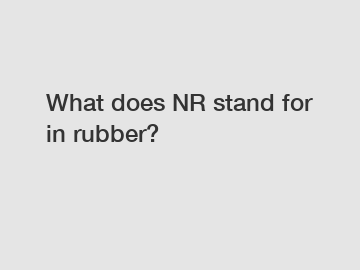What does NR stand for in rubber?
What does NR stand for in rubber?
Rubber is a versatile material widely used in various industries, from automotive to healthcare. Manufacturers often use abbreviations and codes to identify different types of rubber and their attributes. One such abbreviation is NR, which is commonly seen in the rubber industry. In this article, we will explore what NR stands for in rubber and its significance. .
Understanding NR in Rubber.

Natural Rubber (NR) is the primary acronym for NR in rubber. It refers to the unprocessed latex derived from the sap of the rubber tree, scientifically known as Hevea Brasiliensis. The rubber tree is indigenous to South America, but it is now extensively cultivated in various tropical regions worldwide, including Southeast Asia and Africa.
NR is a critical and valuable material in the rubber industry due to its exceptional elasticity, high tensile strength, and resistance to abrasion. These properties make NR suitable for a wide range of applications, such as tires, hoses, belts, footwear, adhesives, and many more. .
Production Process.
To obtain NR, rubber trees are first tapped by making diagonal incisions in the bark. The milky latex then oozes out, which is collected in cups attached to the trees, similar to how maple syrup is harvested. The collected latex is then refined to remove impurities and other components, resulting in a raw form of NR.
After the raw NR is produced, it undergoes several treatments and processes to enhance its physical properties. Vulcanization, for instance, is a common process that involves heating NR with sulfur and other additives to improve its strength, elasticity, and resistance to heat and chemicals. This process is crucial for making durable rubber products.
Advantages of NR.
Natural rubber offers several advantages over its synthetic counterparts. Its excellent elasticity allows NR to stretch and recoil, making it ideal for applications like tires where flexibility is essential. NR also has impressive tear resistance, making it more durable in high-stress applications compared to synthetic rubber.
Furthermore, NR has a low glass transition temperature, which means it remains flexible even in extreme cold conditions. This property is particularly crucial for tires as it ensures better traction and grip on icy or snowy surfaces. .
Limitations.
While NR has remarkable qualities, it does have some limitations. One major drawback of NR is its susceptibility to degradation due to exposure to UV light, ozone, and certain chemicals. To overcome this limitation, manufacturers often add stabilizers and antioxidants to NR compounds to enhance their lifespan.
Another limitation of NR is its high cost compared to synthetic rubber, which can be attributed to the time-consuming cultivation and processing requirements. However, the unique properties and eco-friendliness of NR make it preferred in certain industries, such as healthcare, where synthetic rubber alternatives may not be suitable.
Conclusion.
In conclusion, NR in rubber stands for Natural Rubber, which refers to the unprocessed latex derived from rubber trees. NR possesses exceptional elasticity, tensile strength, and resistance to abrasion, making it a valuable material in numerous industries. Though NR has some limitations, its advantages, such as high tear resistance and flexibility in extreme temperatures, make it a preferred choice in various applications. If you have any further questions about NR or any other rubber-related queries, feel free to contact us.
[Contact us for any further queries regarding NR or any other rubber-related questions.].
If you want to learn more, please visit our website Stud Stable Cow Rubber Mat, Abrasion Resistant Rubber Sheet, Diamond Hammer Top Cow Rubber Mat.

Comments